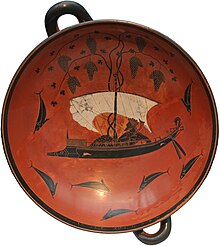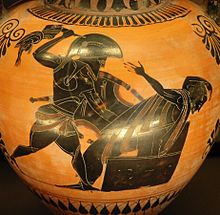User:Tdroback/sandbox
Exekias, an ancient Greek vase-painter and potter who was active in Athens between roughly 545 BC and 530 BC[1], depicted warfare in ancient Greece in many of his works of art. This depiction of warfare is critical in understanding what war at the time was like. One of the most notable is on the Dionysus Crossing the Sea Eye Cup. Another notable depiction of warfare from Exekias is on the Death of Achilles Amphora. These two works of artwork are good examples of Exekias' depictions of warfare in ancient Greece.

Dionysus Crossing the Sea Eye Cup
[edit]The Dionysus Crossing the Sea Eye Cup by Exekias was created in 6th century B.C.; it is presumed to have been created in the exact year of 530 B.C[2]. It was found in Attika Greece, and measures to 30.5 cm long. The depiction of warfare on this Kylix, the most common type of wine-drinking cup in ancient Greece[3], is seen on each side near the handles of the cup, which is often referred to as the Handles with Struggle. Three hoplite soldier figures, who are wearing Corinthian style helmets, are seen one in front of the other, creating a sense of depth on both sides. Added color was used on this part of the Kylix as purple to bring out the armor of the hoplite soldier figures. The hoplite soldiers are shown standing over a body on both sides. It is believed that the hoplite soldiers are fighting over Patroklus' body. [4]The myth of Patroklos, the ally of Achilles, holds that he was killed fighting the Trojans, while wearing Achilles' armor, and the armor was then stolen by the Trojans. On one side of the cup the fallen warrior does not have armor left and is being dragged. On the other side the fallen warrior, which is theorized to be Patroklus, is still wearing all of his armor.[5] This depiction of hoplites standing over a fallen warrior displays the connection between Greek myth and actual warfare in ancient Greece due to the possible connection to Patroklos.

The Death of Achilles Amphora
[edit]Another notable depiction of warfare by Exekias is on the Death of Achilles Amphora, which is thought to have been made between 540 and 530 B.C[6]. This Amphora is created using the black figure technique, and has a height of 58.3 cm and a diameter of 37.5 cm. It was found at the Etruscan city of Orvieto.[7] The depiction of warfare on this amphora is seen through the central image on both sides of the vase as an illustration of the Death of Achilles. The amphora shows a warrior leaning down to lift Achilles up and bring him away from the battlefield, as well as another Greek warrior that is seen with a large shield and a spear stabbing the shoulder of a male with notably African features. It is theorized that the warrior bending down is Ajax, and the other warrior with the large shield is Menelaos. Despite there still not being proof to identify the figures on this amphora, the scholars' theories display again how ancient Greek myth was deeply related to real life warfare, through the Trojan War.[8]
Bibliography
[edit]No Artifact Found, www.perseus.tufts.edu/hopper/artifact?name=Munich%2B2044&object=Vase.
“The Penn Museum.” Penn Museum, www.penn.museum/blog/collection/125th-anniversary-object-of-the-day/greek-amphora-object-of-the-day/.
 | This is a user sandbox of Tdroback. You can use it for testing or practicing edits. This is not the sandbox where you should draft your assigned article for a dashboard.wikiedu.org course. To find the right sandbox for your assignment, visit your Dashboard course page and follow the Sandbox Draft link for your assigned article in the My Articles section. |
- ^ "Exekias". Wikipedia. 2017-10-09.
- ^ "Munich 2044 (Vase)". www.perseus.tufts.edu. Retrieved 2017-12-04.
- ^ "Kylix". Wikipedia. 2017-09-28.
- ^ "Munich 2044 (Vase)". www.perseus.tufts.edu. Retrieved 2017-12-04.
- ^ "Munich 2044 (Vase)". www.perseus.tufts.edu. Retrieved 2017-12-04.
- ^ "Penn Museum Blog | Death of Achilles Greek Amphora [Object of the Day #43] - Penn Museum". www.penn.museum. Retrieved 2017-12-04.
- ^ "Penn Museum Blog | Death of Achilles Greek Amphora [Object of the Day #43] - Penn Museum". www.penn.museum. Retrieved 2017-12-04.
- ^ "Penn Museum Blog | Death of Achilles Greek Amphora [Object of the Day #43] - Penn Museum". www.penn.museum. Retrieved 2017-12-04.
